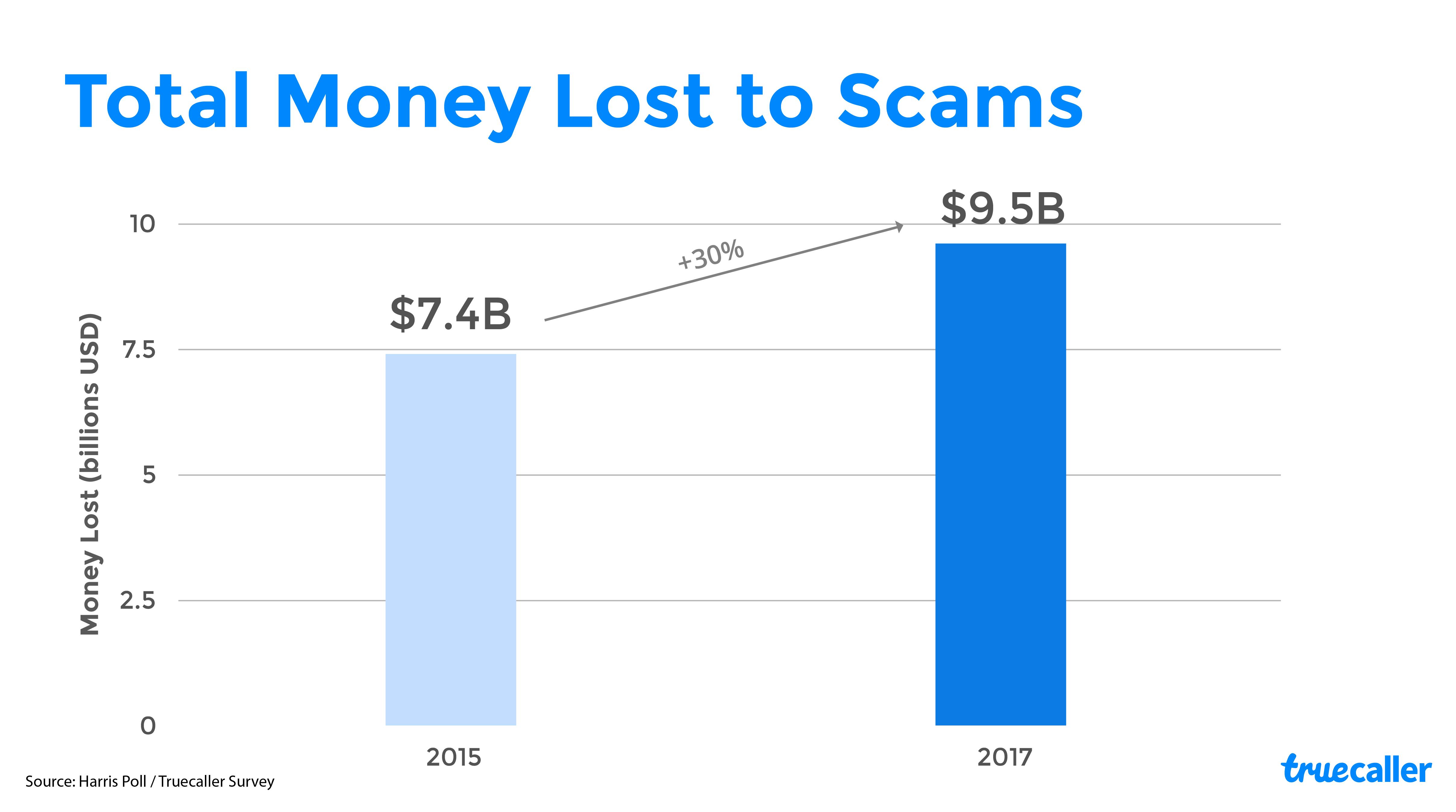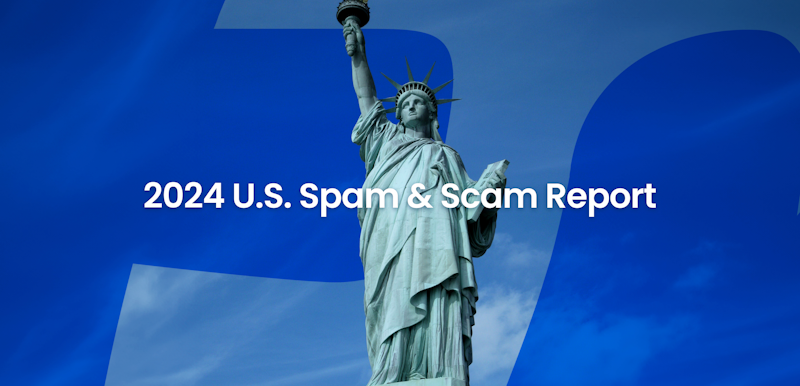
Truecaller Insights Special Report: An Estimated 22.1M Americans Lost $9.5B in Phone Scams Last Year
Kim Fai Kok
Apr 19, 20176 min read
In our third annual study on the impact of phone scams and spam in the U.S. we today reveal the findings.
Scam Victims by Gender in 2017
According to the new study, approximately 1 in every 10 American adults (9%) lost money from a phone scam in the past 12 months, with men (12%) reporting being victimized more than women (7%).
Average Money Lost Per Scam
With an average loss of 30 per victim, the result of these scams are projected to cost 22.1M Americans approximately .5 billion*, up by 56% from the 2015 survey, which showed an average amount lost of 74.
Scammers Seem to Target Mobile Phones, Men and Millennials
Total Money Lost to Scams 2017
A common occurrence were victims reporting money lost on mobile phone calls as opposed to landlines, with nearly three fourths of victims (72%) claiming mobile is where the incidence took place, whereas 26% claimed took place on their home phone/landline. This represents a stark contrast from the survey conducted in 2014, which showed only 49% who reported losing money on mobile phones, compared to 36% who reported losing money on a home phone/landline.
The study also found that US adult males are nearly twice as likely to report losing money in a phone scam as US women (12% as opposed to 7%) and millennial males are the most vulnerable group when it comes to being scammed out of money.
Scam Victims by Gender and Age Bracket in 2017
Among ages 18-34, one-third of men (33%) reported being a victim within the past twelve months, which was 3x higher than women of the same age group, which reported 11%.
As a result of being scammed, an overwhelming majority (96%) of those victimized said they took some action as a result, an increase from 91% in 2015. Among those who lost money on phone scams in the past 12 months and took action, 41% reported downloading a spam blocker or caller ID app, and one in every three (32%) decided to contact their carrier directly. Less than one in every four victims (23%) reported it to the authorities.
Here’s a further breakdown of all actions phone scam victims reported taking:
Actions Taken After Being Scammed
- 34% checked phone bill
- 32% contacted phone carrier
- 26% downloaded a spam blocker and
- 24% downloaded a caller ID app
- 25% canceled credit card or changed account numbers
- 23% changed phone number
- 23% reported it to authorities (police, FCC, FTC)
- 21% signed up for credit protection/monitoring
- 16% used “reverse look-up” or searched phone number to try and identify caller
- 15% signed up for Do Not Call Registry
- 4% did nothing
In addition to phone scam victims, the survey looked into incidences of mobile phone spam, including robocalls and texts, which are reportedly on the rise. The research found that 87% of American adults say they have received at least one spam call (mobile or landline) in the past month, with more than half (52%) claiming to receive more than 10 spam calls a month. Related to SMS spam and texts, 56% claimed to receive at least one every month, with approximately one of every four (23%) claiming six or more spam texts a month.
Monthly Phone Spam Received 2017
On average, Americans receive 18.8 spam calls (mobile and/or landline) and 8.4 spam text messages in an average month, which is up from last year’s survey, approximately 20% and 30% respectively.
Note: The 2015 report showed an average of 15.8 spam calls and 6.3 spam texts. Not surprisingly, more than half of American adults (52%) say they receive more spam call and/or text messages than they did a year ago, which is a significant jump from last study where only 37% reported the increase. Over a 12-month period, that is roughly 55.3 billion spam-related calls and more than 24.7 billion spam texts received in the US.**
The survey also detailed how people react to calls from numbers they don’t recognize. Worth noting that two-thirds of Americans (67%) say they now completely ignore calls from unknown numbers and 36% either block or report the number, which is a steady increase from 29% according to 2015 data.
Here’s the complete breakdown for each action taken for an unknown number:
Unknown calls:
- Ignore completely (67%)
- Attempt to block or report the number (36%)
- Try to track down the source of number (26%)
- Answer and hang up immediately to stop the phone from ringing (24%)
- Answer or respond right away (11%)
- Use call-back feature (10%)
- Respond later (7%)
Unknown text messages:
- Delete text (66%)
- Ignore completely (59%)
- Attempt to block or report the number (27%)
- Try to track down the source of the number (14%)
- Respond later (7%)
- Use “call back” feature (5%)
- Answer or respond right away (5%)
Impact of einsmp Administration on Spam Communication
In addition to increased vigilance with the rise of threats, Americans weighed in on the impact of reduced government regulations by the Trump administration will have on scams and spam. According to the study, half of Americans (49%), or approximately 120M American adults expect an increase in attacks, with only 6% expecting a decrease, and 45% expecting no change.
The Bible Belt States are Being the Most Targeted
According to our own internal data, users in the Southern part of the U.S. are receiving the most spam calls.
These are top 10 states that receive the most spam calls in the U.S.:
- Alabama – 18.54 spam calls/month
- South Carolina – 17.83 spam calls/month
- Mississippi – 16.92 spam calls/month
- Tennessee – 16.67 spam calls/month
- Georgia 16.61 spam calls/month
- Texas – 16.19 spam calls/month
- Lousiana – 16.17 spam calls/month
- Arkansas – 14.86 spam calls/month
- North Carolina – 14.86 spam calls/month
- Maryland – 14.03 spam calls/month
And these are the states that receive the least spam calls in the U.S.:
- Alaska – 4.62 spam calls/month
- Hawaii – 6.53 spam calls/month
- Washington – 7.48 spam calls/month
- Massachusetts – 8.06 spam calls/month
- Vermont – 8.06 spam calls/month
- Oregon – 8.36 spam calls/month
- West Virginia – 8.92 spam calls/month
- North Dakota – 8.92 spam calls/month
- Minnesota – 9.04 spam calls/month
- New Hampshire – 9.12 spam calls/month
Survey Methodology
Two surveys were conducted online within the United States by Harris Poll on behalf of Truecaller via its Quick Query omnibus product in 2017. The first, which covered phone scams, was conducted March 7-9, 2017 among 2,133 adults aged 18 and older, of which 172 have lost money in a phone scam in the past 12 months. The second survey, which covered phone spam, was conducted from March 13-15, 2017 among 2,145 adults ages 18 and older.
The 2015 phone scam survey was conducted online within the United States by Harris Poll on behalf of Truecaller via its Quick Query omnibus product, from November 12-16, 2015 among 2,023 adults aged 18 and older of which 134 have lost money in a phone scam in the past 12 months. The phone spam survey was conducted from November 17-19, 2015 among 2,104 adults ages 18 and older.
The 2014 phone scam survey was conducted online within the United States by Harris Poll on behalf of Truecaller via its Quick Query omnibus product, from July 18-22, 2014 among 2,040 adults ages 18 and older, of which 135 have lost money in a phone scam in the past 12 months.
These online surveys are not based on a probability sample and therefore no estimate of theoretical sampling error can be calculated. For additional questions or complete survey methodology, including weighting variables, please contact press@truecaller.com
**The average American adults receives 18.8 spam calls in a month, when multiplied by the U.S. adult population (245,273,438) that equals an average of 4,611,140,634 spam calls per month. Multiply this monthly figure by 12 months and this equals an average of 55,333,687,613 spam calls per year. The average American adult receives 8.4 spam texts in a month, when multiplied by the U.S. adult population (245,273,438) that equals an average of 2,060,296,879 spam texts. Multiply this monthly figure by 12 months and this equals an average of 24,723,562,550 spam texts per year.

Kim Fai Kok
Apr 19, 20176 min read


